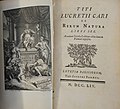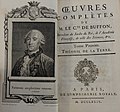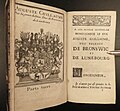
A frontispiece in books is a decorative or informative illustration facing a book's title page, usually on the left-hand, or verso, page opposite the right-hand, or recto page of a book. [1] In some ancient editions or in modern luxury editions the frontispiece features thematic or allegorical elements, in others is the author's portrait that appears as the frontispiece. In medieval illuminated manuscripts, a presentation miniature showing the book or text being presented (by whom and to whom varies) was often used as a frontispiece.










